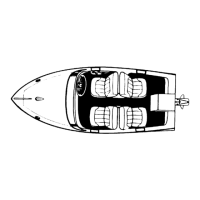90-823225--1 10965E-100 - ELECTRONIC FUEL INJECTION (MULTI-PORT AND THROTTLE BODY)
Diagnostics - Using Scan Tool (Scan)
Code 14 Engine Coolant Temperature (ECT) Sensor Circuit (Scan)
(1 of 2)
ENGINE COOLANT
TEMPERATURE (ECT) SENSOR
ENGINE COOLANT
TEMPERATURE (ECT)
CIRCUIT DESCRIPTION:
The Engine Coolant Temperature (ECT) Sensor
uses a thermistor to control the signal voltage to the
ECM. The ECM applies a voltage on CKT 410 to the
sensor. When the engine coolant is cold, the sensor
(thermistor) resistance is high, therefore, the ECM
will see high signal voltage. As the engine coolant
warms, the sensor resistance becomes less, and the
voltage drops. At normal engine operating tempera-
ture, 160-180°F (71-82°C), the voltage will measure
about 1.5 to 2.0 volts.
TEST DESCRIPTION:
Number(s) below refer to circled number(s) on the
diagnostic chart.
1. Code 14 will set if:
• Signal voltage indicates a coolant tempera-
ture above 266°F (130°C).
• Signal voltage indicates a coolant tempera-
ture below –22°F (–30°C).
2. This test will determine if CKT 410 is shorted to
ground, which will cause the condition for Code
14.
DIAGNOSTIC AIDS:
Check harness routing for a potential short to ground
in CKT 410.
Scan tool displays engine temperature in degrees
Fahrenheit and Celsius. After engine is started, the
temperature should rise steadily, reach normal oper-
ating temperature, and then stabilize when thermo-
stat opens.
See “Intermittents” in “Troubleshooting.”
An intermittent problem may be caused by a poor or
corroded connection, rubbed through wire connec-
tion, a wire that is broken inside the insulation, or a
corroded wire.
Any circuitry that is suspected as causing the inter-
mittent complaint should be thoroughly checked for
backed-out terminals, improper mating, broken
locks, improperly formed or damaged terminals, poor
terminal-to-wiring connections, corroded terminals
and/or wiring, or physical damage to the wiring har-
ness. After repairs, clear codes following “Clearing
Codes” in “ECM Self-Diagnostics.” Failure to do so
may result in codes not properly being cleared.

